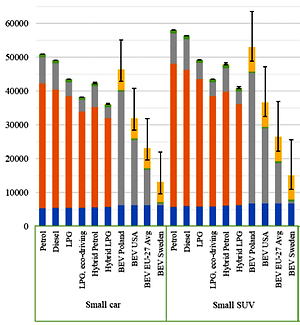Current issue
Online first
Archive
About the Journal
Aims and scope
Publisher and Editorial
Advertising policy
For Authors
Paper review procedures
Procedures protecting authentic authorship of papers
Paper preparation manual
Plagiarism check
Publication ethics
Reviewers
APC
Editorial and Scientific Board
Contact
Reviewers
Comparative analysis of the life-cycle emissions of carbon dioxide emitted by battery electric vehicles using various energy mixes and vehicles with ICE
1
Faculty of Mechanical Engineering, Wroclaw University of Science and Technology, Poland
Submission date: 2021-12-31
Final revision date: 2022-02-16
Acceptance date: 2022-03-06
Online publication date: 2022-03-13
Publication date: 2023-01-02
Corresponding author
Adam Borkowski
Faculty of Mechanical Engineering, Wroclaw University of Science and Technology, Poland
Faculty of Mechanical Engineering, Wroclaw University of Science and Technology, Poland
Combustion Engines 2023,192(1), 3-10
KEYWORDS
TOPICS
ABSTRACT
The research aims to find an effective way to reduce real-world CO2 emissions of passenger vehicles, by answering the question of what kind of vehicles in various countries generates the smallest carbon footprint. Emissions were calculated for vehicles from three of the most popular segments: small, compact and midsize, both with conventional body and SUVs. Each type of vehicle was analyzed with various types of powertrain: petrol ICE (internal combustion engine), diesel ICE, LPG ICE, petrol hybrid, LPG hybrid and BEV (battery electric vehicle) with four different carbon intensity of electric energy source. The final conclusion provides guidelines for environmentally responsible decision-making in terms of passenger vehicle choice.
REFERENCES (29)
3.
Aichberger C, Jungmeier G. Environmental life cycle impacts of automotive batteries based on a literature review. Energies. 2020;13:23. https://doi.org/10.3390/en1323....
4.
Anderson C, Dettmann T. Environmental footprint and performance analysis of a brake disc production line using discrete event simulation. 2013. Available online: https://odr.chalmers.se/bitstr....
5.
Bieker G. A global comparison of the life-cycle greenhouse gas emissions of combustion engine and electric passenger cars. International Council on Clean Transportation. 2021. https://theicct.org/publicatio....
7.
DEFRA/DECC Guidelines to Defra/DECC GHG conversion factors for company reporting. Department of Energy and Climate Change. 2012.
8.
Energiewende A. Agora Energiewende and Ember (2021):The European Power Sector in 2020: Up-to-Date Analysis on the Electricity Transition. 2021. https://static.agora-energiewe....
9.
European Parliament. Council of the European Union. Regulation (EC) 2009, 443(140). https://eur-lex.europa.eu/lega....
10.
FuelEconomy.gov. The Official U.S. Government source for fuel economy information. https://www.fueleconomy.gov/.
11.
Gradin KT, Åström AH. Comparative life cycle assessment of car disc brake systems–case study results and method discussion about comparative LCAs. Int J Life Cycle Ass. 2020;25:2. https://doi.org/10.1007/s11367....
12.
Hill N, Amaral S, Morgan-Price S, Nokes T, Bates J, Helms H et al. Determining the environmental impacts of conventional and alternatively fuelled vehicles through LCA. Final Report for the European Commission. 2020.
14.
How much carbon dioxide is produced per kilowatthour of U.S. electricity generation? Available online: https://www.eia.gov/tools/faqs....
15.
Jato Dynamics, Munoz F. Increased demand for EVs in 2020 contributed to 12% fall in Europe’s average CO2 emissions. 2021. Available online: https://www.jato.com/wp-conten....
16.
Jaworski A, Lejda K, Lubas J, Mądziel M. Comparison of exhaust emission from Euro 3 and Euro 6 motor vehicles fueled with petrol and LPG based on real driving conditions. Combustion Engines. 2019;178(3):106-111. https://doi.org/10.19206/CE-20....
17.
Kettunen M. No more room for friction in our sustainability efforts. Available online: https://www.neste.com/blog/bas....
18.
Laskowski PP, Zimakowska-Laskowska M, Zasina D, Wiatrak M. Comparative analysis of the emissions of carbon dioxide and toxic substances emitted by vehicles with ICE compared to the equivalent emissions of BEV. Combustion Engines. 2021;187(4):102-105. https://doi.org/10.19206/CE-14....
19.
Life Cycle Assessment. Audi looks one step ahead. 2011. Available online: https://docplayer.net/21911056....
20.
Masson-Delmotte V, Zhai P, Pirani A et al. Climate change 2021. The physical science basis. Contribution of Working Group I to the Sixth Assessment Report of the Intergovernmental Panel on Climate Change. 2021, 6. https://www.ipcc.ch.
21.
Merkisz J, Pielecha J, Fuć P. Badania i analizy zużycia energii i emisji zanieczyszczeń przez pojazdy w sieci drogowej. Komitet Inżynierii Lądowej i Wodnej PAN, Warszawa, 2013.
22.
Prussi M, Yugo M, De Prada L, Padella M, Edwards R, Lonza L. JEC well-to-wheels report v5, EUR 30284 EN. Publications Office of the European Union. 2020. https://doi.org/10.2760/959137.
23.
Sitnik L. Emissions of e-mobility. Combustion Engines. 2019;178(3):135-139. https://doi.org/10.19206/CE-20....
25.
Sun X, Zheng J H, Zhang P, Zhao MN, Wu HX, Yan YT. Comparative life cycle assessment of Chinese radial passenger vehicle tire. Mater Sci Forum. 2017;898:2432-2445. https://doi.org/10.4028/www.sc....
26.
The new Audi A3 Life Cycle Assessment. 2012. Available online: https://docplayer.net/29037623....
27.
The new Audi A8 Life Cycle Assessment. 2018. Available online: https://www.audi.com/content/d....
28.
The new Audi R8 Life Cycle Assessment. 2015. Available online: https://www.audi.com/content/d....
29.
The new Audi TT Coupé Life Cycle Assessment. 2015. Available online: https://www.audi.com/content/d....
CITATIONS (4):
1.
Assessment of the life cycle of city buses with diesel and electric drive in the operation phase
Paweł Regulski
Combustion Engines
Paweł Regulski
Combustion Engines
2.
Market positioning of internal combustion engines and battery electric motors
Aleksandra Kęska, Mateusz Dziubek, Dawid Michalik
Combustion Engines
Aleksandra Kęska, Mateusz Dziubek, Dawid Michalik
Combustion Engines
3.
The economic aspects of vehicle operation in the context of electromobility strategies
Aleksandra Kęska, Mateusz Dziubek, Dawid Michalik
Combustion Engines
Aleksandra Kęska, Mateusz Dziubek, Dawid Michalik
Combustion Engines
4.
Electric Vehicles, Biofuels, and Transitions in Transportation Energy
Diana M.R. Gutierrez, Michael R. Ladisch
Industrial Biotechnology
Diana M.R. Gutierrez, Michael R. Ladisch
Industrial Biotechnology
We process personal data collected when visiting the website. The function of obtaining information about users and their behavior is carried out by voluntarily entered information in forms and saving cookies in end devices. Data, including cookies, are used to provide services, improve the user experience and to analyze the traffic in accordance with the Privacy policy. Data are also collected and processed by Google Analytics tool (more).
You can change cookies settings in your browser. Restricted use of cookies in the browser configuration may affect some functionalities of the website.
You can change cookies settings in your browser. Restricted use of cookies in the browser configuration may affect some functionalities of the website.



